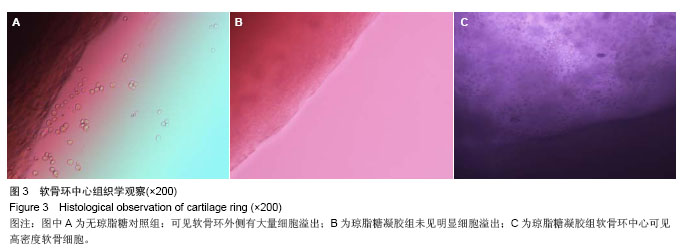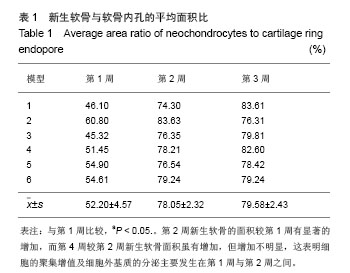| [1]Alcaraz MJ, Megías J, García-Arnandis I, et al. New molecular targets for the treatment of osteoarthritis. Biochem Pharmacol. 2010;80(1):13-21.
[2]张志奇,廖威明,傅明.骨关节炎的遗传基因及基因治疗[J/CD].中华关节外科杂志:电子版,2010,4(4):67-70.
[3]Xing L, Jiang Y, Gui J, et al. Microfracture combined with osteochondral paste implantation was more effective than microfracture alone for full-thickness cartilage repair. Knee Surg Sports Traumatol Arthrosc. 2013;21(8):1770-1776.
[4]邢麟子,桂鉴超,徐燕,等.微骨折技术结合自体骨软骨碎屑样移植修复兔膝关节软骨缺损的实验研究[J].中华创伤骨科杂志, 2012, 14(5):424-428.
[5]Gulotta LV, Rudzki JR, Kovacevic D, et al. Chondrocyte death and cartilage degradation after autologous osteochondral transplantation surgery in a rabbit model. Am J Sports Med. 2009;37(7):1324-1333.
[6]Zhang Z, McCaffery JM, Spencer RG, et al. Growth and integration of neocartilage with native cartilage in vitro. J Orthop Res.2005;23(2):433-439.
[7]陆一鸣,桂鉴超,徐扬,等.软骨细胞迁徙能力与自体细胞软骨移植中整合的相关性[J].中国组织工程研究,2013,17(44): 7721-7728.
[8]Normand V, Lootens DL, Amici E, et al. New insight into agarose gel mechanical properties. Biomacromolecules. 2000; 1(4):730-738.
[9]Cournil-Henrionnet C, Huselstein C, Wang Y, et al. Phenotypic analysis of cell surface markers and gene expression of human mesenchymal stem cells and chondrocytes during monolayer expansion. Biorheology. 2008;45(3-4):513-526.
[10]Schnabel M, Marlovits S, Eckhoff G, et al. Dedifferentiation-associated changes in morphology and gene expression in primary human articular chondrocytes in cell culture. Osteoarthritis Cartilage. 2002;10(1):62-70.
[11]Dell'Accio F, De Bari C, Luyten FP. Molecular markers predictive of the capacity of expanded human articular chondrocytes to form stable cartilage in vivo. Arthritis Rheum. 2001;44(7):1608-1619.
[12]Hunziker EB. Articular cartilage repair: basic science and clinical progress. A review of the current status and prospects. Osteoarthritis Cartilage.2002;10(6):432-463.
[13]Nehrer S, Spector M, Minas T. Histologic analysis of tissue after failed cartilage repair procedures. Clin Orthop Relat Res. 1999;(365):149-162.
[14]Peterson L, Minas T, Brittberg M, et al.Two- to 9-year outcome after autologous chondrocyte transplantation of the knee. Clin Orthop Relat Res. 2000;(374):212-234.
[15]Tuli R, Li WJ, Tuan RS. Current state of cartilage tissue engineering. Arthritis Res Ther. 2003;5(5):235-238.
[16]Tuli R, Li WJ, Tuan RS. Current state of cartilage tissue engineering. Arthritis Res Ther. 2003;5(5):235-238.
[17]Benya PD, Shaffer JD. Dedifferentiated chondrocytes reexpress the differentiated collagen phenotype when cultured in agarose gels. Cell. 1982;30(1):215-224.
[18]Jakob M, Démarteau O, Schäfer D, et al. Specific growth factors during the expansion and redifferentiation of adult human articular chondrocytes enhance chondrogenesis and cartilaginous tissue formation in vitro. J Cell Biochem. 2001; 81(2):368-377.
[19]Li Y, Tew SR, Russell AM, et al. Transduction of passaged human articular chondrocytes with adenoviral, retroviral, and lentiviral vectors and the effects of enhanced expression of SOX9. Tissue Eng. 2004;10(3-4):575-584.
[20]Wolf F, Candrian C, Wendt D, et al. Cartilage tissue engineering using pre-aggregated human articular chondrocytes. Eur Cell Mater. 2008;16:92-99.
[21]Hattori S, Oxford C, Reddi AH. Identification of superficial zone articular chondrocyte stem/progenitor cells. Biochem Biophys Res Commun. 2007;358(1):99-103.
[22]Bernstein P, Sperling I, Corbeil D, et al. Progenitor cells from cartilage--no osteoarthritis-grade-specific differences in stem cell marker expression. Biotechnol Prog. 2013;29(1):206-212.
[23]Koelling S, Miosge N. Sex differences of chondrogenic progenitor cells in late stages of osteoarthritis. Arthritis Rheum. 2010;62(4):107710-107787.
[24]Gerter R, Kruegel J, Miosge N. New insights into cartilage repair - the role of migratory progenitor cells in osteoarthritis. Matrix Biol. 2012;31(3):206-213.
[25]Gaissmaier C, Koh JL, Weise K. Growth and differentiation factors for cartilage healing and repair. Injury. 2008;39 Suppl 1:S88-96.
[26]Fortier LA, Mohammed HO, Lust G, et al. Insulin-like growth factor-I enhances cell-based repair of articular cartilage. J Bone Joint Surg Br. 2002;84(2):276-288.
[27]Khan IM, Gilbert SJ, Singhrao SK, et al. Cartilage integration: evaluation of the reasons for failure of integration during cartilage repair. A review. Eur Cell Mater. 2008;16:26-39. |



.jpg)
.jpg)
.jpg)